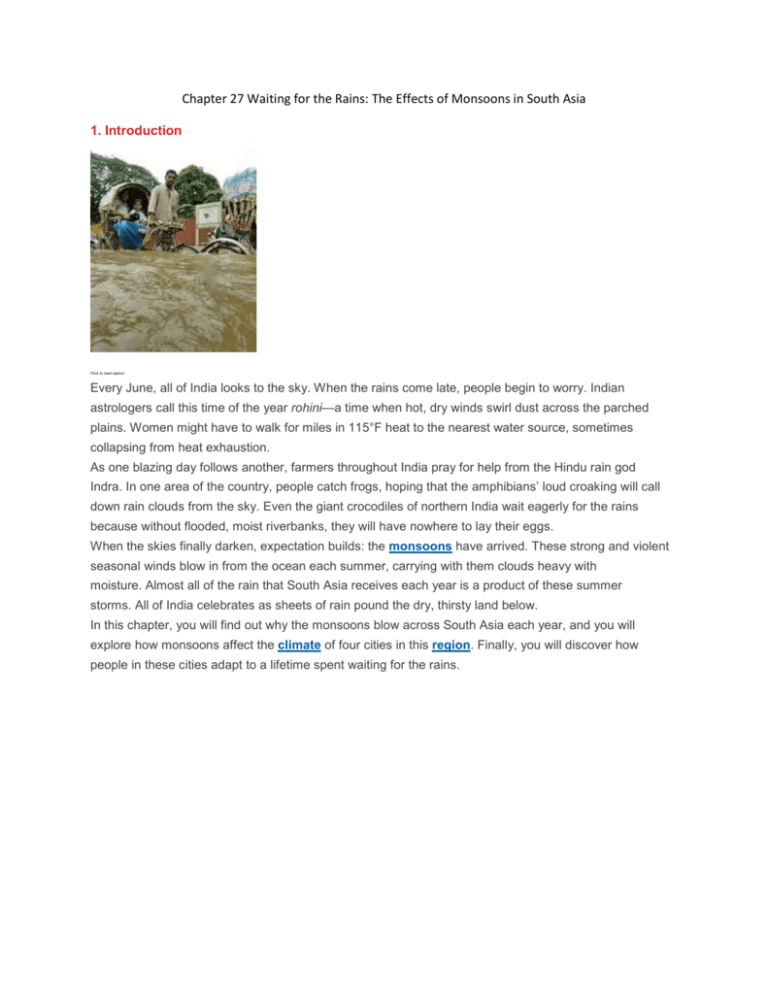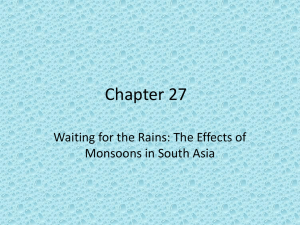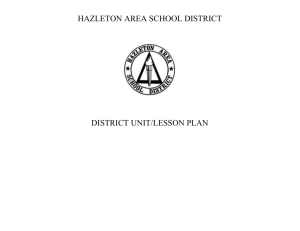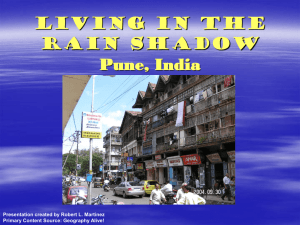5. Waiting for the Rains in Kolkata, India
advertisement

Chapter 27 Waiting for the Rains: The Effects of Monsoons in South Asia 1. Introduction Click to read caption Every June, all of India looks to the sky. When the rains come late, people begin to worry. Indian astrologers call this time of the year rohini—a time when hot, dry winds swirl dust across the parched plains. Women might have to walk for miles in 115°F heat to the nearest water source, sometimes collapsing from heat exhaustion. As one blazing day follows another, farmers throughout India pray for help from the Hindu rain god Indra. In one area of the country, people catch frogs, hoping that the amphibians’ loud croaking will call down rain clouds from the sky. Even the giant crocodiles of northern India wait eagerly for the rains because without flooded, moist riverbanks, they will have nowhere to lay their eggs. When the skies finally darken, expectation builds: the monsoons have arrived. These strong and violent seasonal winds blow in from the ocean each summer, carrying with them clouds heavy with moisture. Almost all of the rain that South Asia receives each year is a product of these summer storms. All of India celebrates as sheets of rain pound the dry, thirsty land below. In this chapter, you will find out why the monsoons blow across South Asia each year, and you will explore how monsoons affect the climate of four cities in this region. Finally, you will discover how people in these cities adapt to a lifetime spent waiting for the rains. 2. The Geographic Setting Click to read caption South Asia juts out into the Indian Ocean like a giant triangle, forming a very large peninsula that is also known as the Indian subcontinent. The Himalaya mountain range cuts this subcontinent off from the rest of Central Asia. One out of every five people on Earth lives in South Asia. Most of them are farmers who both look forward to and fear the coming of the monsoons. Changes in Atmospheric Pressure Create Monsoons Have you ever heard a weather forecaster talk about an area of high pressure or an area of low pressure? These terms are references to high or low atmospheric pressure, which is the weight of theatmosphere pressing down upon the surface of Earth. Falling cool air creates areas of high pressure, while rising warm air creates areas of low pressure. In a high-pressure area, cool air from the upper atmosphere presses down toward Earth’s surface and, in the process, causes atmospheric pressure to increase. With all of this downward pressure, very little surface air can rise into the upper atmosphere to form clouds. High pressure generally means sunny days and no rain. The opposite happens within a low-pressure area, in which warm surface air moves easily into the upper atmosphere. If this air is moist, it forms clouds that bring rain. Air from high-pressure areas will naturally flow into low-pressure areas. This movement of air creates wind. During the spring and summer months, the air over the South Asian landmass warms up faster than the air over the Indian Ocean. As this hot air rises, it creates a low-pressure area. As a result, the cool, moist air that is over the Indian Ocean flows into the area of low pressure. This movement of air creates the summer monsoons. During the fall and winter months, however, the air over South Asia cools down and then sinks, forming an area of high pressure. This high-pressure area keeps the moist air that blew in with the summer monsoons far out to sea. From October to March, only a small amount of rain falls throughout South Asia. During this long dry period, South Asians must deal with dusty fields and dwindling water sources. Mountain Ranges Create Rain Shadows Mountains affect where summer storms will drop their moisture. A mountain slope facing upwind, or against the direction of the monsoon winds, generally receives a large amount of rain. In contrast, a slope facing downwind, or in the same direction the wind is blowing, will receive far less rain. Geographers call the impact that mountains have on rainfall patterns the orographic effect. The orographic effect works this way. When clouds blow up against mountains, the moist air rises up along the slopes of the mountains. As the air rises, it gradually cools. Since cooling air cannot hold as much moisture as warm air, the clouds release their moisture as precipitation—either rain or snow. By the time the clouds have crossed over the mountains, little moisture remains in them. As a consequence, people living on the downwind side of the mountains receive very little rainfall. That dry area is called a rain shadow. People living in a rain shadow have to adapt to life with little rain. 3. The Wet Months in Dhaka, Bangladesh Click to read caption About 13 million people live in Dhaka, the capital city of Bangladesh. For the residents of Dhaka, July can be a difficult month. In July 1996, the homes of approximately 3 million people were flooded. Two years later, about 1,500 people perished during July floods. Their deaths were blamed on everything from drowning to disease. In July 2004, rains left much of Dhaka under water. One of the World’s Wettest Capitals Most of Bangladesh lies on a river delta that seldom rises more than 30 feet above sea level. Rice, a crop that grows best in warm, shallow water, thrives here.In July, however, the monsoon rains often raise the rivers to dangerously high levels. When the rivers flood, even rice finds it difficult to survive. Dhaka, which is located in the center of Bangladesh, has one of the wettest climates on Earth. Up to 80 inches of rain falls there each year, with most of this rain coming during the summer months. From November to April, the weather is dry. Flooding is not Dhaka’s only problem. In addition, Bangladesh is often pounded by tropical cyclones. Tropical cyclone is another name for hurricane. Because Dhaka is situated at sea level, the city is often lashed by high winds and waves during these violent storms. Life Depends on the Rains Bangladesh’s economy depends on agriculture. Nearly three out of every five people farm the country’s rich delta soil, relying on the monsoon rains to water their fields. When the summer rains are late, crops such as rice, sugarcane, tea, and tobacco will suffer. Sometimes the monsoons bring too much rain too rapidly, flooding the fields. The deep water makes it impossible to plant and harvest the crops. Dhaka also suffers from too much rain. When the streets flood, car and bus traffic comes to a halt. Schools and businesses close down because no one can get to work. Meanwhile, floodwaters pollute the city’s drinking water supply, creating conditions in which disease spreads rapidly. Children growing up in Dhaka learn early that the rains that bring life to local fields can also end life in the city. 4. The Dry Months of Jodhpur, India Click to read caption The Mehrangarh Fort rises out of the desert like a towering giant, looking down on the “Blue City” of Jodhpur, India. The city gets its nickname from the fact that most of the houses are painted blue.Some people say that this color is used to keep away mosquitoes. In July 2002, nearly half of Jodhpur’s crops could not be planted because the summer monsoons were late. The worst droughtin more than 40 years had begun. A City on the Edge of a Desert Jodhpur sits at the eastern edge of the Thar Desert in northern India. This region is a leading producer of cattle, spices, and grains. It has a typical semiaridclimate, with hot, dry weather throughout most of the year. The people living in and around Jodhpur are accustomed to their semiarid climate. In most years, the city receives only about 14 inches of rain. The average temperatures do not drop below 60°F, even in the winter. Summer monsoons bring much-needed rains from June to September. Click to read caption Water Is a Critical Resource Approximately 80 percent of the people living around Jodhpur are farmers, but farming is difficult in this dry region. The desert soil requires a great amount of water to produce crops, and farmers depend on the monsoons for that water. How much rain will come and when will it arrive are questions people here ask every year. The rains come late in some years. Sometimes too little rain falls, resulting in crop failures and shortages of drinking water.Families that run out of food sometimes survive by eating samas, a wild grass. As people grow weak from hunger, disease spreads more easily. The people of Jodhpur have learned to adapt to their semiarid climate. In addition to growing crops, many farmers raise livestock, which can survive on native plants when crops fail. To conserve water, some farmers have begun to use drip irrigation, in which water drips directly onto a plant’s roots. With the use of this irrigation method, little water is wasted as runoff or to evaporation. This careful use of water makes sense in Jodhpur, where every drop counts. 5. Waiting for the Rains in Kolkata, India Click to read caption Kolkata is a city of contrasts that has been described as both the “City of Joy” and the “Dying City.” Its modern skyscrapers tower over the muddy Hooghly River, which is a branch of the Ganges River.When the monsoons come during the month of June, the river floods. After a rain shower or two, Kolkata finds itself knee-deep, or even neck-deep, in water. Wet Summers and Dry Winters Almost 15 million people call Kolkata home. About a third of the city’s residents live in slums. The city’s winters are dry and pleasant, with moderate winds blowing in from the north. From June to September, the winds shift directions, as the moist monsoon air blows in from the Indian Ocean. Themonsoons can dump nearly 50 inches of rain on the city in only four months, and temperatures can soar to 100°F. Clearly these summer rains present a great challenge to the people of Kolkata. Monsoon Rains Begin and End Life Kolkata floods easily. The city’s old canals overflow quickly when rainwater fills the streets, and buses and taxis can’t navigate the flooded roads. Children must wade to school through waist-high water and spend the day in wet clothing. Nevertheless, the monsoon rains are welcome because the farmers need the rain to water their crops. The rains also provide relief from the sticky summer heat. Kolkata has had to find ways to deal with the summer floods. In the past, a system of canals drained floodwater out of the city. This system was later abandoned in favor of modern streets and sewers, but when too much rain falls, garbage clogs the old canals. Standing water in the flooded streets breeds mosquitoes. Diseases that are carried by mosquitoes, such as malaria, then spread quickly, causing people to sicken and die. Today, officials in Kolkata are looking at rebuilding the city’s antiquated canals to help with the flooding. Meanwhile, sewer lines are being repaired so that they can carry more water during storms. The city is also working to keep the river clear of debris so that more water can drain downstream during heavy rains. 6. Living in the Rain Shadow: Pune, India Click to read caption The city of Pune, located on the Deccan Plateau in western India, is only 115 miles from Mumbai—a short two-hour drive. Yet Mumbai receives at least 70 inches of rain during the summer monsoons; in contrast, precipitation in Pune totals only 29 inches for the entire year. A Year-Round Dry Climate Between Mumbai and Pune lies a mountain range known as the Western Ghats. As the monsoon winds rise up the slopes of these mountains, the air cools and releases its moisture. By the time the monsoon winds reach the downwind side of the mountains, the air retains very little moisture. Pune sits in a rain shadow on the opposite side of the Western Ghats from Mumbai. While the coastal city of Mumbai must brace for heavy rain, Pune is spared from flooding. For most of the year, the air is dry and pleasant, and the monsoons bring welcome rains from about June to September. Limited Rainfall Makes Water Precious The people of Pune have learned to survive with little water. In the past, farmers here raised sugarcane, a crop that requires large quantities of water.Today, they plant crops that are more drought resistant, such as sugar beets. Pune has also tried to increase its rainfall with cloud seeding, a process that involves scattering chemicals into clouds in order to bring about rain. Rain falls when the water vapor in clouds condenses into droplets, which form around tiny specks of ice in the air. Under the appropriate conditions, clouds can be seeded to encourage this condensation to occur. Usually, this seeding is accomplished by spraying the clouds from the air with tiny amounts of either silver iodide or dry ice.The hope is that water droplets will form around these “seeds.” It is hard to determine just how effective cloud seeding has been in Pune because no one knows how much rain might have fallen if there had been no seeding. However, for people living in a rain shadow, the chance of more rain makes seeding seem worth the expense. Summary - Beginning to Think Globally In this chapter, you learned how monsoons affect the climate of South Asia. The differences in atmospheric pressure between the land and sea cause the summer monsoons, and these winds bring both welcome rain and deadly floods to coastal cities. The orographic effect also shapes the climate of this region. Cities on the downwind sides of mountains often lie in a rain shadow. Unlike their coastal cousins, the people in these cities must adapt to limited rainfall. Other regions also have monsoons. From November to April, for example, northern Australia braces for its monsoon season. Monsoons hit the West African coast from May to July. In Arizona, monsoon rains arrive in the middle of summer, as moist air from the Gulf of Mexico blows inland. Wherever people live, the climate will affect their activities. Think about this as you examine the variety of climates around the world in the next section. Global Connections The map shows climate zones around the world. The three climagraphs show the average monthly temperatures and precipitation in three cities. How might climate affect the type of housing people build? In hot and humid tropical climates, people build homes that will allow the breezes to flow through. In dry desert climates, builders of homes make windows small to keep out the sunlight. In very wet climates, people build houses that are elevated on stilts; the raised houses will stay dry when the land below floods. In regions with tundra climates, houses are also raised off the ground, thereby allowing cold air to flow underneath the buildings. Otherwise, the warmth of a house could melt the permafrost, or the permanently frozen ground, below. If the permafrost were to melt, the house might sink into the mud. How might climate affect the type of clothing people wear? People who live in regions with arid climates often wear loose-fitting, flowing clothes. They want to cover up most of their skin to avoid being too exposed to the sun. People who reside in more temperate places like London have come to expect daily downpours, so they keep umbrellas and raincoats handy. How might climate affect what people do for fun? In Alaska, dog sledding and ice fishing are common cold-climate sports. Surfing is popular in Hawaii. North Africans enjoy camel racing. In Namibia, people gather at the dunes in the Namib Desert to sandboard. Much like snowboarding, sandboarding involves sliding down a slippery slope of sand on a wooden board.






